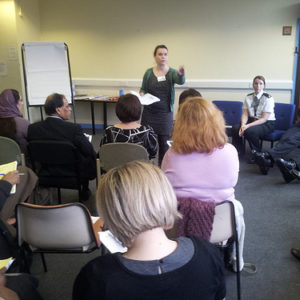Barry Ahern explains the Enneagram and it’s nine personality styles, each with their distinctive patterns of thinking, feeling and behaving.
Imagine you suddenly received a road map that gave you profound insights into how you thought, felt and related to others. How do you think you would react?
Such is the accuracy of the Enneagram in describing nine personality styles. Each of these illustrates a distinctive pattern of thinking, feeling and behaving. As a result, a common response is to describe the experience as being “so real that it’s eerie.” People can be overawed or pleasantly surprised by discovering a description that is so much part of your way of being.
Many people believe that the Enneagram is the most effective training instrument available. It describes the starting point each of us takes dealing with information, our colleagues and our work environment. We all know the importance of giving and receiving feedback. However, most of us have no idea as to how others see us.
For most of us, our first objective encounter with ourselves is when we hear our voices on an audio and/or visual recording for the first time. Most of us react negatively to the experience. However, if you repeatedly do so, it is a useful way of getting to know an aspect of yourself. Based on that, we can adjust or change what we project out to others.
The Enneagram provides one of the most profound ways of understanding ourselves. People often have questions about it, however. We look at them here.
Is it not rather limiting to start putting people in a box?
The fact is, we are already in a box. It is part of human nature to categorise things. This helps us to understand our world. The nine point personality system helps us overcome our limitations. We become more open and receptive to seeing reality as it is. At the same time we are all uniquely different from each other.
So what is this nine point personality system about?
The Enneagram is a dynamic system of nine personality types. It offers insights into the nine different ways people organise their patterns of perception. There are nine types and none are better than the other. Each of the personality types has a distinctive pattern of thought, feeling and action. Each has a specific viewpoint or belief structure. This determines what is important to you and how you interact with the world.
For example, Type Three is often called the Performer. Type Threes dedicate themselves to achievements and rewards. They believe that the world rewards winners and that runners-up get nothing. They are goal-oriented. Therefore, they cram their days with activity, and their fear of failure keeps the momentum moving forward. Slowing down is threatening, especially if they have to talk about feelings. What they don’t realise is that others don’t see things that way. Theirs is only a narrow version of reality. To be really effective, they have to go beyond their box.
Before meeting any group, each participant looks at descriptions of nine workplace interactive styles and chooses their preferred options. Each of the descriptions outlines a particular world view in snapshot form. I never cease to be surprised at how quickly participants discover something about their own motivations. When they meet others during the training and share their preferences, it can be startling to discover how much they have in common with some people and how strikingly different others are, and yet it all makes sense. It throws light on the motivation underlying behaviours which previously caused misunderstandings.
Doesn’t it all sounds suspiciously simplistic?
The system is most accessible to anyone with a healthy level of emotional intelligence and a capacity to self-observe. For them, the system can represent a fast-track to an advanced level of self-management. The system is open to scientific verification. This is because the descriptions are distilled from the direct experience of thousands of people. They who have observed their own patterns and self-identified what makes sense to them. The case history below illustrates how different personality types may interact and clash with each other.
Meet Tom, the consensual leader
Tom is European director of a large corporate hospitality and event management group. He is well liked in corporate circles and had a reputation for setting up major events that run smoothly. Everyone on Tom’s team knew that he was available should they need to contact him, by phone or in person.
Tom is a Type Nine. Type Nines are called Mediators. They want to keep the environment they’re in calm and comfortable. They like to include everyone in decision making. Type Nines listen to others without adding their own opinions and judgements. There is a desire to avoid conflict at all costs, as this would invite them to take a stand, something they dread. Arriving at a decision can take a long time. They a constantly weigh up of different points of view in order to ensure a solution that involves no-conflict.
Ironically, sitting on the fence, hoping that things will work out, often invites what they dread – conflict. This is because in when decisions aren’t made, sooner or later someone gets angry. The upside of this is that Type Nines can be marvellous team builders and excellent leaders. They have a great capacity to give everyone a fair hearing.
Meet Claire, the perfectionist
Claire is Tom’s second-in-command and has been working closely with him for five years. Early on, Claire enjoyed working with Tom. She found him easy going, supportive and he gave her a wide berth.
Over time, Claire noticed that Tom avoided dealing with people whose work was not up to standard. She rarely saw him take a firm stand. She reported failings of outsourcing contractors regularly and wanted Tom to fire some of them. He rarely did. She became irritated by this. It meant that she often worked long hours to ensure that everything was up to standard. She thought contractors took advantage of Tom and delivered an inferior service. She couldn’t tolerate this any longer.
Claire planned to leave the company in the middle of a big project. A main subcontractors nearly caused a disaster for a major client. If it not been for her intervention it would have caused a major headache and lost a lot of goodwill. This was unacceptable to her.
Tom too had noticed the contractor’s failures. He knew it was serious and that he should do something about the contractor. However, he kept postponing it. He didn’t want any discord in the camp.
Claire is a Type One, sometimes called the Perfectionist. Perfectionists believe everyone needs to put one hundred percent effort into everything they do. For Type Ones, standards are paramount. Their attention is geared towards righting that 5 percent that isn’t up to standard. They are also orientated towards duty rather than pleasure.
Type Ones can be particularly demanding and critical towards themselves. This is often hidden from others behind a smile and a tight jaw. Sometimes this can spill over to others.
How can the Enneagram model help in this situation?
The first task in using the Enneagram is to self-identify your own pattern of attention. This involves being honest with yourself, which isn’t easy for anyone.
Type Nines must be prepared to identify how much attention is paid to others’ agendas, to the neglect of one’s own and how much energy is spent in avoiding conflict. A major growth area for them is learning to act on their own behalf. They need to understand that this might involve learning to tolerate conflict and disagreements at times.
For the Type One it can mean looking at how much attention is being paid to error and what needs correcting. The growth area is realising there is more than one right way. When all the parties understand where the other is coming from major shifts can occur quite rapidly. As a result, people begin to support each other in dealing with their blind spots.












Comments